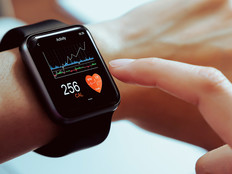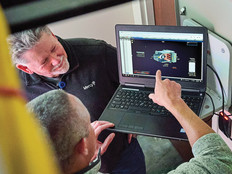Digital tools continue to play a greater role in improving every aspect of healthcare. But a divide still exists — between some organizations that aren’t adopting them, and among patients that might lack the technologies, internet access or motivation to take advantage of them.
Still, progress is being made on many fronts, according to the College of Healthcare Information Management Executives’ “HealthCare’s Most Wired: National Trends 2019” report. Unveiled Tuesday at the CHIME19 Fall CIO Forum in Phoenix, the research examines key challenges and developments in healthcare IT adoption and strategy.
SUBSCRIBE: Become an Insider for access to exclusive HealthTech videos, white papers and articles.
A common thread: Care is increasingly no longer confined to the walls of hospitals or clinics, which presents heightened legal, logistical and cybersecurity challenges.
“Folks, especially younger patients, want to interact with you — on whatever modality and at whatever time of day,” said Aaron Miri, CIO at Dell Medical School and UT Health Austin, who on Tuesday spoke on a panel about the CHIME report. “From telemedicine to chatbots and face-to-face appointments, organizations have to do a lot of balancing.”
And while improvements in tech development, employment and infrastructure are often necessary (as are efforts to boost patient adoption), the report notes the transformation can drive higher patient satisfaction, improved health and savings of time and money.
Here are some of the report’s findings that affect IT teams, along with relevant commentary from this week’s CHIME events and discussions:
Patient Portal Capabilities Continue to Grow
Increasing comfort with patient portals can reap a much greater reward over time. “Regardless of a facility’s size or type, the impact of their patient engagement technology on outcomes (patient, clinician, operational or financial) increases as more patients use the portal,” the report notes.
Ninety-eight percent of respondents said they supply a patient portal for functions such as test results and discharge instructions. But double-digit gains were seen in less common abilities — including self-scheduling and transmitting insurance and medical history details directly to an electronic health record.
Dr. Wendy Sue Swanson, a CHIME keynote speaker and former chief of digital innovation at Seattle Children’s, suggested on Tuesday at the conference that developers take a cue from Starbucks and its popular mobile app to facilitate consumer-friendly and HIPAA-compliant exchanges for greater adoption.
READ MORE: When purchasing healthcare tech, make sure nurses are involved.
Telehealth Options Are Expanding, but User Participation Lags
Although 90 percent of participants said they offer some type of virtual services, two-thirds of survey respondents report fewer than 10 percent of patients have used them. Among post-acute care centers, places where telehealth can make an impact, that availability drops to just 24 percent.
Benefits seen within the subset could encourage clinicians and patients reluctant to adapt. “Even with that small patient use, they still reported high outcomes of patient engagement,” Lauren Barton, director of market analysis for KLAS Research, said on Tuesday. “There’s opportunity as well.”
Demonstrating value is crucial, Pamela Arora, senior vice president and CIO of Children’s Health, said on Tuesday. Her organization provides telehealth in more than 140 Florida schools. As such, “a child can return to class with a doctor’s OK, or a prescription can be called in for a parent to pick up on the way home,” Arora said.
Most Healthcare Cybersecurity Programs Need Improvement
There’s no question that all organizations need protection. But the CHIME report found that only 37 percent of respondents said they have adopted all 11 components of comprehensive security program — and a wider gap exists between small and large hospitals as well as between rural and urban ones.
Among those cited as “comprehensive,” however, half still have no policy for medical device security. “Once hackers are inside, they’re inside,” Charles Christian, CTO of Franciscan Health, said on Monday. Such breaches not only disrupt care, they can spur multimillion-dollar violation fees.
To that end, receiving CHIME’s top designation now requires five extra steps: security workforce training, risk management tactics shared with executive leadership, annual vulnerability assessments and business associate inventories, and a dedicated security operations center.
Doctors Lack Remote Access to Key Workflow Tools
Despite rising mobility initiatives and telemedicine efforts, it’s difficult for some providers to offer comprehensive care from a distance. The good news: One hundred percent of respondents offer their clinicians remote access to EHR systems, which the report calls “the center of patient care.”
The largest gains in remote-access capabilities, the report found, were seen in virtual patient visits and secure texting. Less than half of organizations, though, facilitate advanced functions such as access to alerts for chronically ill patients and to data from implants or smart devices.
Enhanced cybersecurity can reduce silos for remote work. “Quit worrying about the device — manage the data and access to that data,” John McFarland, senior director of business and technology management at Moffitt Cancer Center, said on Tuesday. “Once you do that, it’s a very different world.”
Patient Data Is More Important Than Ever
A surge of self-reported and provider-collected data is giving a clearer picture of wider trends in population health. It also helps keep tabs on individuals’ progress. When ingested directly into the EHR, the report notes, data from patient-monitoring equipment can reduce human error.
“We’re starting to see sophisticated equipment moving outside the hospital and toward the home,” Cara Babachicos, senior vice president at CIO at South Shore Hospital, said on Monday. “Ready-to-use devices with a small footprint allow us to ingest that data and make more critical decisions.”
There’s room for improvement: Organizations less often integrate data such as tracking of hospital-acquired infections and clinical summaries from outside organizations. Likewise, data from tools such as IV pumps and ventilators are sent to EHRs less than 50 percent of the time.
Follow us on Twitter @HealthTechMag, or the official CHIME Twitter account, @CIOCHIME, and join the conversation using the hashtag #CHIME19.










